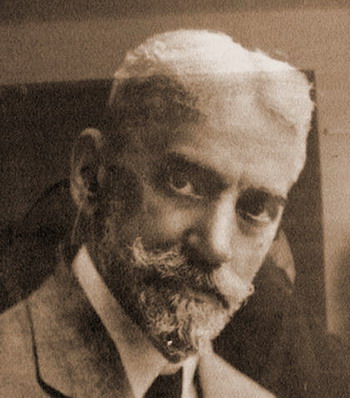8.5.5 Hubertus Christian de Blanck Valet (Hubert de Blanck)

Hubertus Christian de Blanck Valet, known internationally as Hubert de Blanck, was a prestigious performer, composer, and educator. He was born in 1856 in Utrecht, Holland. He received his first musical training from his father, the violinist Wilhelm de Blanck. He enrolled at the Liège Conservatory in Belgium at the age of nine, where he learned piano with Felix-Etienne and music theory with Sylvain Dupuis.
In 1867, he won second prize in piano for Hummell’s E minor concerto. This would mark the beginning of a highly successful career as a pianist, composer, and conductor. As a teenager, he gave recitals at the Royal Palace in Brussels. King Leopold II awarded him a scholarship to refine his art at the Cologne Conservatory in Germany, in the fields of harmony and composition.
In 1873, he toured Russia, Sweden, Germany, Switzerland, and Norway. At just 18 years of age, he returned to Cologne, having been elected Conductor of the El Dorado Theater in Warsaw, Poland. There, he met Eugene Maurice Danguemont, a Brazilian, then considered a precocious violin genius. The two embarked on extensive tours and performances on stages throughout Europe and South America. They appeared at the court of Emperor Pedro II in Brazil, as well as in Argentina. In 1881, after appearing at the Royal Palace in the presence of William I, Emperor of Germany, he bid a final farewell to Europe.
In the United States, he gives concerts as a soloist, accompanied by the New York Philharmonic Orchestra. His success and dedication to teaching led to his selection as a professor at the New York College of Music, where he began his career as a teacher in charge of piano.
Hubert de Blanck arrived in Havana in 1882 with his wife, the Cuban Ana García Menocal, performing in the salons of Havana’s Centro Gallego with Anselmo López and Serafín Ramírez. A year later, upon returning to the city, he decided to remain there permanently.
On October 1, 1885, he opened a music conservatory at number 100 on Paseo del Prado, the first of its kind in the country. Over the years, the educational center changed locations several times. Finally, in the middle of the following decade, the conservatory was located at number 3, Calzada de Reina.
Hubert de Blanck secured the opening of the Conservatory of Music and Declamation. His creativity was revelatory in the field of teaching. The competitions, held as incentives for outstanding students graduating in the first year (1885-1886), were the first held in Cuba for music students; they were his initiative.
Blanck’s friendly relationship with and admiration for Nicolás Ruiz Espadero was the primary inspiration for naming the concert hall of his Conservatory of Music “Sala Espadero” beginning in 1889. Lecture series were held there, featuring works by Hayden, Mozart, Beethoven, Shubert, Mendelssohn, Schumann, and others. For many years, this hall was considered one of the most important concert venues in Cuba.
Maestro Blanck was imprisoned by the colonial government for being a member of the Revolutionary Junta in Havana and deported from Cuba. He then moved to New York, where he remained, offering private lessons and as an accompanying pianist.
After his arrival in this city, from the first months of his life, he became involved with the group of Cuban artists who were raising funds for the island’s independence cause. It was during this time that he composed his illustrious piano work, Paraphrase, based on the Cuban National Anthem. It premiered at one of the patriotic musical evenings established by the group.
At the end of the Cuban-Spanish-American War, the maestro returned to Havana in 1898, establishing his Conservatory at 124 Galiano Street (upstairs), corner of Dragones Street, Havana; he later relocated to other addresses. The last location of this center would be on Calzada between A and B, Vedado, where the Hubert de Blanck Theater remains today (Calzada between A and B, Vedado, Plaza de la Revolución, Havana).
One of his most important compositions is the opera Patria (with a libretto by Ramón Espinosa de los Monteros). This work is the first to address the theme of the Cuban independence struggle. The premiere of its second act and the performance of its prelude are known to have taken place in 1899 at the Tacón Theater. The composer was directed by the composer, and the performance was by soprano Chalía Herrera and Italian tenor Michele Sigaldi.
Hubert de Blanck officially became a Cuban citizen in 1903. The conservatory relocated again to expand its facilities, to 47 Galiano Street, between Concordia and Virtudes streets. It now has an enrollment of more than 600 students and a large number of academies have been added to its curriculum throughout the island.
Hubert de Blanck compiled a comprehensive catalogue of works, including more than thirty works for piano; voice and piano; violin and piano; symphony orchestra and band; chamber music and opera theater; as well as several educational texts.
Blanck composed numerous works for piano, including: Caprice Cubane, Dance of the Witches, Bolero in D minor, Danza cubana, Souvenir de La Habana, Dance espagnole, and the album Six Dances for Piano. His chamber music works include the Trio for violin, cello, and piano, and his Quintet for two violins, viola, cello, and piano. His works for symphony orchestra include Caprice Cubane, Symphonic Suite, Symphonic Poem, and March and Funeral Song.
His style was post-Romantic; he blended all genres with a prolific stylistic mastery and attention to form, preserving a lyrical, fluid, and inspired melody of great musical tenacity.
After receiving numerous honorary awards from prestigious Cuban institutions, Maestro Hubert de Blanck died in Havana on November 28, 1932. This important musician constitutes an irrefutable and unbreakable cultural link between the Netherlands and Cuba.








